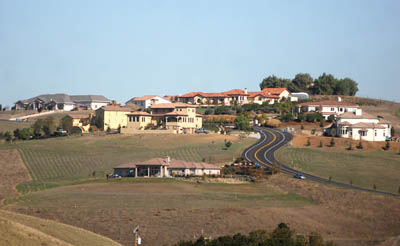
If Board Chairman Anthony Botelho has his way, supervisors
before the end of the year will mold new laws to ease restrictions
on developers when it comes to affordable housing and the growth
cap guiding the rate at which large builders can construct. It’s a
bold agenda to wrap up Botelho’s year as board chairman and would
stand to change a set of constraints on developers
– established when rapid growth was a concern several years back
– which officials concede have led to stagnant growth in San Benito
County and concerns about its effect on the economy.
HOLLISTER
If Board Chairman Anthony Botelho has his way, supervisors before the end of the year will mold new laws to ease restrictions on developers when it comes to affordable housing and the growth cap guiding the rate at which large builders can construct.
It’s a bold agenda to wrap up Botelho’s year as board chairman and would stand to change a set of constraints on developers – established when rapid growth was a concern several years back – which officials concede have led to stagnant growth in San Benito County and concerns about its effect on the economy.
The two ordinances under review and facing major changes are set to get to the board for public hearings at separate meetings Dec. 15 and Dec. 16, Botelho said, which would leave the potential to have them resolved by the time he steps down and another chairman takes the gavel.
The main component of the update to the affordable housing law is a recommendation from the board’s planning commission, approved last week, to drop the requirement that 30 percent of units in developments are designated as low income. The growth management ordinance – which features the 1 percent annual cap – faces a set of potential changes. Some include exempting major developments with voter approval from the countywide cap and aligning the yearly maximum with the state’s growth rate, as opposed to a flat, largely inflexible number.
“We’re trying to find the right formula where it’s reasonable for developers to be able to be profitable, but yet address the needs we have as a county,” said Botelho, the District 2 supervisor representing the San Juan Bautista area.
There’s a fine line supervisors are set to consider on the affordable housing law in particular, between offering enough incentive for developers to build while also maintaining a suitable stock of lower-income homes. Since the board enacted the law in early 2004, there has been a concerning lack of development, affordable or not, in San Benito County limits.
One of the problems, especially considering the impact here from the foreclosure crisis and a coinciding plummet in home values, is that officials are not all that clear on how much of the housing stock is, per se, affordable.
“I think we need to have that information,” Botelho said. “I have requested that from staff to see if we can have some sort of idea.”
With the recommendation from planning commissioners, the 30 percent affordable requirement would go away altogether along with a rule mandating smaller developers to pay in-lieu fees instead of building affordable units.
Other provisions in the ordinance would remain to maintain administration locally of affordable housing efforts – such as applying for federal grants and working with the city’s housing officials to create the most appropriate, fair balance here, said Art Henriques, the county’s head planning official. The county by state law also must provide structured incentives for builders who choose to include a certain percentage of affordable units in their projects.
For the full story, see the Free Lance on Tuesday.









